Printing Company
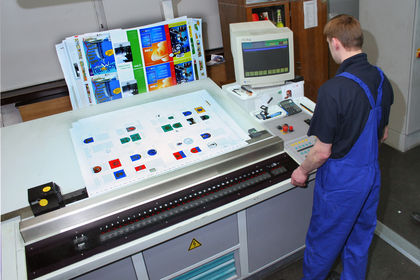
BUSINESS PLAN
MASTER PRINTER AND PARTNERS PRINTING
52 James St.
Grace, NM 84753
6924 Auburn Dr.
Grace, NM 84753
June 23, 1990
This business plan outlines a two-store operation offering a full range of printing services and supplies. The joint enterprise will improve efficiency through the use of Total Quality Management (TQM). Following is a description of the ways in which the companies will employ extensive use of strategic, operational, and financial planning, as well as ways they intend to incorporate TQM methods into their businesses .
- EXECUTIVE SUMMARY
- BUSINESS DESCRIPTION
- COMPANY HISTORY
- MARKET ANALYSIS
- MARKETING STRATEGY
- OPERATIONS
- JOB FLOW DESCRIPTION
- MANAGEMENT AND ORGANIZATION
- GOALS AND OBJECTIVES
- HISTORICAL FINANCIAL ANALYSIS AND OPERATIONAL GOALS
- FINANCIAL INFORMATION
- BALANCE SHEET
- SUPPLEMENTAL DOCUMENTS
EXECUTIVE SUMMARY
There are two components to this company: Master Printer of Grace and Partners Printing of Theadora. Master Printer has been owned, all or in part, by Shawn Russell since 1981. Ms. Russell started Partners in 1990 to increase market share and penetrate the Theadora market. The firm lost a major contract in 1991. This experience caused the first major loss in eight years. It is our goal to diversify the sales to the extent that we will never be dependent on one customer to that degree again. In addition, we will improve our efficiency and effectiveness through the implementation of Total Quality Management (TQM).
The two stores offer a full range of printing services and supplies. We have the ability to operate as a "quick printer" when necessary. A full list of services is included in the Business Description section.
The market is divided into commercial taxable and nontaxable accounts. We are currently identifying the number of potential accounts. The main competition is Charter Stationary, Langston Printing, and Monroe's Print Shop in Grace, and Penny Printing and Paper Supplies and Priceless Printing in Theadora. Our company will emphasize service, quality, price, and speed of service to compete in the market place. The printing industry is growing at a rate of 8 to 11 percent a year. We estimate our market share to be 34.2 percent and plan to increase that to 44.4 percent in five years through the implementation and annual revision of this plan.
Master and Partners have the ability to offer full-line printing services. The labor force consists of 13 people who have 150 combined years of printing and/or sales experience. We will use a delivery service to get the products to our customers in the outlying areas and for customers who need rush service.
We presently have a need for the following funds:

| Payoff existing loans/notes | $161,000 |
| Accounts Payable | 64,000 |
| Operating Capital | 25.000 |
| TOTAL | $250,000 |
We would like to have this loan over a 12-year term at 8.34 percent interest.
This business plan makes extensive and exhaustive use of strategic, operational, and financial planning. An essential element of this plan is the installation of the TQM method.
BUSINESS DESCRIPTION
Master Printer and Partners Printing offer a range of services, including:
- Offset printing
- Limited in-house full-color
- Job out balance of full-color
- Forms
- Books, manuals, brochures
- Programs
- Checks
- Computer typesetting with Apple Macintosh and Varitype
- Letter press
At the current time our regular customers are:
- Percy's Restaurant
- Jim's Video Arcade
- Grace School System
- Pine Acres Rest Home
- First Bank
- Government Printing Facility
- Sarah's Stitchery
- Others
In addition to the few accounts listed above, we have approximately 100 accounts not listed (i.e., churches, businesses, clubs, etc.).
COMPANY HISTORY
Master Printer is a local commercial printing company that has recently expanded to Theadora, New Mexico. Master was established in Grace, New Mexico in 1889 as a local newspaper printer, along with a job print shop. It was created to meet the printing needs of the local community.
After a period of time, the job print shop was sold as a commercial print shop. It was owned and operated as Grace Printing Company by Mrs. Dorothy Simmons.
In 1935, an employee, Drake Master, purchased Grace Printing Company and changed the name to Master Printer. During 1945, Mr. Master had a building erected at 52 James Street. This site remains the location of the present shop.
Master Printer was operated by Mr. and Mrs. Master until 1972. A few years after the death of Mr. Master, the shop again changed hands. It was sold to Mrs. Jane Appleton, who had been an employee of the company for 20 years.
In January 1981, Ms. Appleton sold Master Printer to two employees, Arthur Banes and Jack Wilson. Annie Reese became a junior partner.
Master Printer operated under this general partnership until it was dissolved in October of 1984. It was during this time that Shawn Russell became the sole proprietor of Master Printer.
In October of 1990, Shawn Russell expanded to Theadora, New Mexico. She opened a print shop under the name of Partners Printing. The two locations are full service printing companies and offer a wide range of printing products and services.
MARKET ANALYSIS
Potential Customers:
In addition to our current customers, I have identified the following businesses that will help diversify our revenue base:
- Tandy Toy Store
- Wednesday's
- Thomas, Bailey, & Hardy
- Jamie's Boutique
- Ralph White's Hardware
Small customers that have been overlooked in the past, such as physicians, young professionals, nonprofit organizations, and small businesses in our market area will be identified by next December.
Estimated Printing Market Size and Competition:
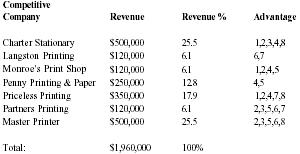
| Competitive Company | Revenue | Revenue % | Advantage |
| Charter Stationary | $500,000 | 25.5 | 1,2,3,4,8 |
| Langston Printing | $120,000 | 6.1 | 6,7 |
| Monroe's Print Shop | $120,000 | 6.1 | 1,2,4,5 |
| Penny Printing & Paper | $250,000 | 12.8 | 4,5 |
| Priceless Printing | $350,000 | 17.9 | 1,2,4,7,8 |
| Partners Printing | $120,000 | 6.1 | 2,3,5,6,7 |
| Master Printer | $500,000 | 25.5 | 2,3,5,6,8 |
| Total: | $1,960,000 | 100% |
Legend
- Location
- Service
- Quality
- Selection of Service
- Price
- Speed
- New Business
- Equity
The threats within the local market are:
- New print shop(s)
- Price wars
- Lawsuits
- New and better copiers, for in-house do-it-yourselfers
- Brokers
These are only potential threats, so no plan of action is necessary at this time. It is important to recognize and monitor these items for future strategy.
MARKETING STRATEGY
Target Markets
We are going to strengthen our local market by concentrating on increasing our smaller business accounts, as mentioned above. We estimate that by concentrating on maintaining our existing accounts and securing new accounts, our market share will increase as follows:
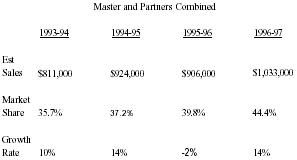
| Master and Partners Combined | ||||
| 1993-94 | 1994-95 | 1995-96 | 1996-97 | |
| Est Sales | $811,000 | $924,000 | $906,000 | $1,033,000 |
| Market Share | 35.7% | 37.2% | 39.8% | 44.4% |
| Growth Rate | 10% | 14% | −2% | 14% |
We intend to price our services and products just below or equal to our competition. The goal is to accomplish this while maintaining superior service over our competitors. We can accomplish this through efficiency, company training sessions, and by concentrating on quality control.
We will emphasize our perceived competitive advantage of service, quality, and price, to penetrate the market. To accomplish this, our promotion plan will include:
Public Relations
We intend to have periodic meetings and training sessions teaching employees how to communicate effectively with customers on the phone, and in person. One of our aims, in hopes of satisfying our customers, is to demonstrate alternative ways to do their printing. This should, in many cases, save them time and money. These training sessions are scheduled on the master calendar. (See Supplemental Documents section for information about the company calendar).
Advertising and Sales Incentives
We will develop a series of radio commercials that will be effective in exposing both companies to our market areas. We plan to have periodic promotions offering discounts or specials on various printing items (i.e. business cards, envelopes, letterheads, etc.). We will be able to determine what means of advertising will be most effective for our companies by utilizing these promotions at different intervals on various types of media. Campaigns will be initiated at the monthly Marketing Evaluation Meeting as scheduled on the monthly calendar.
Outside Sales
Outside sales has been a weak area. It has been targeted as a major area of emphasis. We are presently utilizing certain employees who we feel are qualified to work in outside sales. By readjusting production and work schedules, we are certain that the volume of business should noticeably increase for both companies.
Surveys
We will survey present customers and potential customers in an effort to find the weak and strong areas of our products and services. This will be accomplished by utilizing outside sales people and the mail service. Through this survey, we should be able to gain valuable information giving us a competitive edge over our competition. Surveys are also scheduled on the master calendar. A sample survey has been provided in the Supplemental Documents section.
If the marketing goals, as outlined above, are not within 25 percent of projection by February 1, 1994, then the following strategy will be implemented immediately:
- Additional emphasis will be placed on outside sales by doubling our sales efforts.
- A 25 percent increase in radio advertising will be initiated.
- Additional promotional incentives will be implemented.
- A conference will be held with our accountant and banker.
If the marketing goals are still not met by July 1, then a marketing consultant with proven experience in the printing industry will be hired to implement a successful strategy.
OPERATIONS
The printing plants are located at 52 James Street for Master Printer and 6924 Auburn Drive in Theadora for Partners Printing. The combined labor cost for both companies is $121 per hour. Our operations consist of the following procedures:
First, the customer places the order. The employee taking the order should get as much information from the customer as possible (filling out the job worksheet should be sufficient). Also, at the time the employee receives the order a reasonable time should be determined for completing the job. The customer should be notified of any changes occurring with the order.
JOB FLOW DESCRIPTION
Second, the job ticket with all the information should be completed and documented in the job log book. The typesetter should be notified if typesetting is needing or the job should be taken directly to layout if all of the information is camera-ready. If the job is a repeal order, it should also be taken to layout.
Third, the typesetter should typeset any required copy as specified by the customer. Questions or problems should be directed to the person who took the order. No work should leave the typesetter until it has been properly proofed by two or more employees.
Fourth, every time typesetting is done for a customer, the customer must see a proof before printing is done. Therefore, the client is to be called in for proofing and they should sign a proof slip after reviewing the completed work. A customer who is proofing the typesetting that we have done should be encouraged to check spelling, phone numbers, etc. for accuracy.
It is a good idea, and should be a regular practice, for an employee to go over the proofing process with the customer and review the printing specifications as they are printed on the job ticket. Take nothing for granted and never ASSUME anything.
Fifth, after the proofing and correction stage, the job should go to layout, where logos and art work are added, an original is made, and a plate is prepared for printing.
Sixth, the plate is taken to a pressman. The pressman's job is to pull the stock required for the job and then print it to the specifications on the ticket. Again, the pressman should not assume anything. If there is any question or doubt as to the specifications of printing the job, the pressman should take the questions to the shop foreman for clarification.
Seventh, the job is printed and then goes to the bindery for any bindery work needed (i.e. collating, numbering, padding, cutting, gathering, packaging, etc.). When all bindery work is done and the job is complete, it should either be delivered or taken to the front office for pick-up.
Eighth, the delivery person or the front office employee should get a signed delivery receipt and/or a signed in voice when the job is picked-up. The delivery receipt should then be placed in the job envelope and the envelope filed in the completed box. The invoice also has its assigned place and should be filed there without fail.
Personnel in each department should be aware of the delivery dates requested by customers. The work schedules should ensure that these dates are met. Should a job be held up in a department that will affect the delivery dates, the customer should be notified to help maintain proper public relations.
Also, it is the responsibility of the bookkeeper to make sure that all customers are invoiced weekly and that statements are in the mail at the proper time. Any time an invoice can be delivered with the job, it should be, as this will eliminate unnecessary postage and work load in the front office.
MANAGEMENT AND ORGANIZATION
Managers
The managers' duties are quite encompassing, as they oversee all shop employees. Therefore, this job requires knowledge of operational procedures, people skills, and a very broad knowledge of shop equipment maintenance. Further duties and responsibilities are:
- Management of each department supervisor
- Ordering supplies and all paper stock
- Overseeing the completion of jobs and ensuring quality control
- Maintaining schedules
- Cost controlling and waste management which requires shop personnel to use stock that is cut and left from previous jobs, instead of cutting down new stock
- Responsible for monitoring job flow and ensuring that each order is on schedule
- Taking job orders, answering the phone if the front office needs help, and waiting on customers
A listing of all management goals that have been derived as a result of this plan are listed in the Supplemental Documents section.
When the previous months financial statements are received, these procedures will be reevaluated and appropriate changes will be made. If the cost containment measures are not effective, then changes will be made. Financial reviews are scheduled on the monthly calendar.
Target percentages for the line items that will be monitored for containment are:

| Cost of Sales | 35% |
| Auto Expense | 1% |
| Telephone | 0.8% |
| Maintenance and Repairs | 0.5% |
TQM will be instituted after management is educated on the benefits and short comings of the process. TQM has been scheduled on the master calendar.
GOALS AND OBJECTIVES
Management Goals
- Recapitalize through loan proceeds.
- Initiate a plan of action to create a better working atmosphere.
- Reduce cost and increase profits.
- Through new formats and procedures, increase profitability.
- Strengthen present customer base and expand customer base to outside areas (Rosemond, Alareado, Mansfield, etc.).
- Update equipment to expand into more specialized areas of the printing market.
- Increase employee benefits.
Operational Goals
Cost Contain
- Contain all costs within FRA guidelines where applicable.
- Establish a regular insurance audit to determine needs and reduce cost where applicable.
- Install TQM in phases as indicated on the master calendar.
- Examine costs on a regular basis during monthly financial review.
Implement the following accounting changes:
-
Capital Expenditures
These items are projected to be purchased in the following time frame:

February 1994 equipment improvements approximately $5,000 July 1995 additional equipment purchases (typesetting equipment, presses) $30,000
Productivity/Efficiency Goals
- Contain waste through regular management meetings, at the present time and through TQM methods in the long-run.
- Install employee suggestion box with cash incentives for suggestion that result in cost savings on increased productivity. This will lead to a team based presentation program through TQM in the long-run.
- Outline Quality Control Procedures. (See subsection on Production and Quality Control).
Timing
Business Plan complete - September 21st
Loan Funded - October 2nd
A management calendar has been developed to indicate projection dates for reaching strategic decision goals. It is also used to schedule strategic planning sessions, evaluations, and general meetings.
HISTORICAL FINANCIAL ANALYSIS AND OPERATIONAL GOALS
Information about obtaining the comprehensive historical income statements can be found in the Supplemental Documents section. The following text is a summarized version of these statements.
An analysis of the 12-year trend indicates an increase in revenue for 11 of the past 12 years. The year, 1981, is the exception to this trend.
In 1981, Shawn Russell was adjusting to making management decisions, while continuing her work as a presswoman. The work force consisted of the two general partners, one junior partner, one full-time employee, and occasional part-time help. The high number of employees resulted in lower salaries and wages for that year.
In 1982, there was a considerable salary increase without a corresponding increase in sales or gross profit. The difficulties experienced in the partnership limited sound management decisions. This salary increase, along with the absence of an active sales force, contributed to a decrease in gross profits for the company by 1984.
In August of 1984, the partnership realized that it needed to disband. It was dissolved in October of 1984. After the dissolution of the partnership, the shop has realized steady growth.
Several expense line items have been analyzed and have provided opportunities for cost containment.
Cost of Goods
This item appears to have been out of proportion at certain periods. To remedy this, several steps have been and will be taken.
- Procedures are being taken to monitor material waste. Waste due to errors can be considerably reduced by implementing and enforcing policies on quality control.
- Pricing updates will be made more often to reflect price increases on papers and supplies. Price lists have recently been updated and modified to simplify pricing procedures for employees. This will be a major help in eliminating pricing errors.
- Each department will be responsible for recording time spent on each job. This will show what types of printing jobs are more or less profitable, and indicate what measures should be taken to increase profitability.
Wages (including owners)
Wages have averaged 28.6 percent over the 12 year history. Current labor expense is high, 37.3 percent of gross sales, due to the loss of the Hillman Equipment contracts. The figures are ½ actual and ½ projection. One employee has been terminated and one employee quit. As a result, this percentage should be lower by year end. The FRA (Financial Research Association) comparison for a like-size business indicates a 35.98 average. Therefore, Master Printer and Partners Printing are only 1.32 percent above this industry average. Increases in productivity brought about through the implementation of this plan will bring this figure to below the industry average.
Payroll Taxes
Payroll taxes have increased from .7 percent in 1981 to 3.7 percent in 1992. However, this line item is only controllable indirectly through total labor.
Advertising
Advertising is .7 percent on average and is above the FRA average of .39 percent for small-sized businesses. In order to increase our penetration in the market, this item will have to remain above this average for a short time. However, we do feel that by utilizing an effective advertising strategy, our advertising dollars will yield a greater return than in the past.
Auto Expense
Auto expense was .8 percent in 1982, and 1.9 in 1992, or a 237 percent increase. There are no industry averages for this line item, but it is deemed to be high.
The increase is contributed primarily to the frequent trips and distance from Grace to Theadora. These trips should be less frequent due to the loss of certain Hillman contracts. Therefore, this expense should decrease without an action plan.
Bad Debts
Bad debts have not been a significant problem in the past, but we will continue to monitor accounts receivable to avoid developing any problems in this area.
Insurance
Insurance costs have escalated from .4 percent of gross to 1.2 percent and are in line with the FRA industry average of 1.78 percent.
Interest
Interest has moved from 2.3 percent of gross to 2.8 percent in 1991, which is a 21.7 percent increase in 11 years. We hope to reduce our interest expense by obtaining a loan at lower interest rates than we are presently paying.
Lease Expense
Lease expense has fluctuated over the years, starting at 4.6 percent in 1981 and decreasing to 2.3 percent in 1991. We hope to reduce this expense even further by purchasing equipment, rather than acquiring it on lease options. The purchases will be evaluated with our accountant to determine what items will be most advantageous at the time.
Repairs and Maintenance
Repairs and maintenance increased significantly from 1981 through 1988. This was due in part to service agreements on new equipment. From 1988, however, this expense has significantly decreased from .77 percent of revenues to .37 percent.
FINANCIAL INFORMATION
Pro-forma income statement projections and balance sheets are available from the main office of Harris, Ridder, & Manny, Inc., 6734 Desert Drive, Grace, NM 84753. The following is a summary of their findings and recommendations.
Two pro-forma income statements were constructed for the purpose of analysis. One is based on the current debt structure and the other focuses on a capital restructuring program. The first indicates a net cash position of $18,348 at year end, while the second reveals a new cash position of $25,016. The capital restructuring program is as follows:

| Payoff existing loans/notes | $161,000 |
| Accounts Payable | $64,000 |
| Operating Capital | $25.000 |
| TOTAL | $250,000 |
Of the $25,000 in operating costs, $10,000 will be placed in a money market account and marked for emergency use only. This account will be built to a level of $26,000, which is ten percent of gross profit. It will be maintained at that level in accordance with the gross profit figures.
Historical growth has occurred at 15 percent over the last 11 years. However, for purposes of this analysis, the growth rate was held to ten percent. The actual year to year growth rate varies in accordance with the ebb and flow of the local economy. The 1995-1996 fiscal year shows an actual decrease in sales, something the company has experienced only once in the past 11 years.
Owing to greater efficiencies and economies of scale, the net cash available grows from $25,223 in 1993-1994 to $80,404 in 1994-1995.
A FMV balance sheet was constructed because of the extensive depreciation the company currently has on the books. A market analysis was obtained from the company (See Supplemental Documents) to establish the value of the real property. The value of the equipment was estimated using replacement costs, instead of new costs, as a guideline. Value was given to the leased equipment only if it was projected to pay out in less than six months. The owners' equity in FMV terms is 34.5 percent.
Cash was used as a plug figure from the income statements. Accounts receivable and inventory were increased at five percent per year, and this amount was subtracted from cash because no allocation was made in the pro-forma income statements. The capital purchases were also subtracted from cash. Depreciation was estimated at the current rate for the life of the projection. After the current period, the payables were reduced to $1,000.
Since the business has a substantial amount of equipment depreciated out or almost out, the net worth figure was modified by adding the FMV net to arrive at an adjusted figure.
BALANCE SHEET
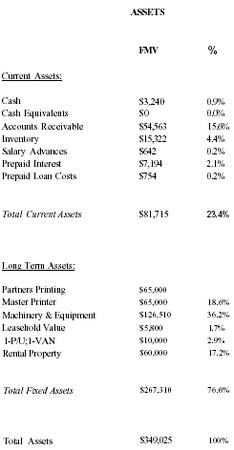
| ASSETS | ||
| FMV | % | |
| Current Assets: | ||
| Cash | $3,240 | 0.9% |
| Cash Equivalents | $0 | 0.0% |
| Accounts Receivable | $54,563 | 15.6% |
| Inventory | $15,322 | 4.4% |
| Salary Advances | $642 | 0.2% |
| Prepaid Interest | $7,194 | 2.1% |
| Prepaid Loan Costs | $754 | 0.2% |
| Total Current Assets | $81,715 | 23.4% |
| Long Term Assets: | ||
| Partners Printing | $65,000 | |
| Master Printer | $65,000 | 18.6% |
| Machinery & Equipment | $126,510 | 36.2% |
| Leasehold Value | $5,800 | 1.7% |
| 1-P/U;1-VAN | $10,000 | 2.9% |
| Rental Property | $60,000 | 17.2% |
| Total Fixed Assets | $267,310 | 76.6% |
| Total Assets | $349,025 | 100% |
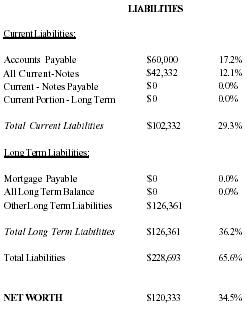
| LIABILITIES | ||
| Current Liabilities: | ||
| Accounts Payable | $60,000 | 17.2% |
| All Current-Notes | $42,332 | 12.1% |
| Current - Notes Payable | $0 | 0.0% |
| Current Portion - Long Term | $0 | 0.0% |
| Total Current Liabilities | $102,332 | 29.3% |
| Long Term Liabilities: | ||
| Mortgage Payable | $0 | 0.0% |
| All Long Term Balance | $0 | 0.0% |
| Other Long Term Liabilities | $126,361 | |
| Total Long Term Liabilities | $126,361 | 36.2% |
| Total Liabilities | $228,693 | 65.6% |
| NET WORTH | $120,333 | 34.5% |
Major Assumptions
- Economy of Grace and Theadora remain relatively the same.
- No "significant" new competition.
- No large capital purchases within two years.
- TQM will be implemented within one year, with resultant efficiencies.
SUPPLEMENTAL DOCUMENTS
Company Calendar
The Master Calendar is a long range planning tool for company managers. It is a five year record of management meetings and programs. Some of the items included on this calendar are: Insurance Audits, Financial Review Sessions, Policy and Procedure Meetings, a schedule for implementation of the TQM Program, and Quarterly Management Summary Meetings.
A copy of the Master Calendar can be obtained from the Master Printer office.
Organizational Chart and Management Resumes
A chart illustrating the management hierarchy has been prepared by the owner, Shawn Russell. Please contact Ms. Russell for a copy.
Management resumes and references are available upon request.
Financial Documents
Tables containing sales figures, gross profit, operating expenses, other income, and net income over the past 12 years have been prepared by Harris, Ridder, & Manny, Inc., 6734 Desert Dr., Grace, NM 84753.
The firm of Harris, et al has also compiled additional financial statements and supplementary schedules including: a proprietorship balance sheet; a table illustrating the proprietor's capital for the one month and eight month period that ended in August of 1993; and other related statements of income. Please contact the main office, at the address listed above, for copies of these financial documents.
Market Analysis
A Market Analysis of local properties has been completed by the Benchman Company, 7483 Riverside Dr., Grace, NM 84753. The report revealed the estimated market value of both single family dwellings and retail office space. The homes ranged from $45,000 to $105,00 and the office facilities were between $9,500 to $70,000. A copy of the full analysis is available upon request.
Employee Guidelines and Production and Quality Control
Production and Quality Control is everyone's responsibility.
Dealing with Customers
Be polite and cordial
A prerequisite and requirement to taking orders is being friendly and cordial, regardless of how bad a day you may have had. Make each customer feel he or she is important and welcome. Every customer is important, so be careful not to be rude or brash.
When a customer arrives, know in advance who is going to deal with their order. Wait on customers immediately. DO NOT keep them waiting. If more than one customer comes in get someone in the back to help.
Receiving Jobs or Information (in person or on the phone)
Write everything down (use the work order form)
- Record person's NAME, TIME of call, and DATE.
- Get the address and phone number if possible.
-
Get a complete and detailed description of what the customer's
request. This includes:
- Type, color, and weight of stock
- Size or sizes of stock
- Color or colors of ink
- Types of bindery required (if necessary)
- Job due date
- Question information that is vague
- Quantity or quantities of order
- Record price quoted if possible
- Do not quote the customer a price unless you are sure of it. Double check the price with someone if possible.
- When receiving information concerning jobs already in production, write down the change and send it immediately to the appropriate department. Make sure that the change is recorded on the job ticket.
- Watch for Obvious Errors: Always check name, dates, and phone numbers.
Follow-Up
Job Orders
After information on Page One has been obtained and recorded, the old job ticket should be pulled and a new ticket should be filled out. Someone other than the person taking the job should call the customer to verify information recorded, including the price.
Proofs
After a proof is ready, with respect to the due date, the customer will be contacted, or proof will be delivered to the customer. If proof has not been picked up or OK'd in a reasonable time, with respect to the due date, a follow-up call needs to be made to the customer.
The same shall apply to completed jobs waiting to be picked up by the customer.
Supplies
If supplies that have been ordered have not arrived in a reasonable amount of time, a follow-up call is to be made to the company. This also applies to orders shipped outside of the print shop.
Errors
- If it is clear where the fault lies, due to carelessness or negligence, the cost of the job may be charged to the person or persons responsible for the error.
-
The majority of errors can be eliminated by follow a few simple
guidelines:
- Communicate effectively
- Work together
- Keep your mind and thoughts on your job
Reducing Expenses
-
Reducing Waste
- Utilized supplies efficiently
- Avoid cutting too much stock
- Be conservative when using supplies. Use only what is needed.
- Designated persons will be responsible for cutting papers and stocks for each job prior to printing
- Each job ticket will be attached to a production control sheet. Each person and department will be responsible for recording the time the project was started and the time it was completed.
-
Production Time
-
Quality Time
- Utilize time efficiently
- Strive to produce 8 hours of quality production daily
-
Overtime
- Work overtime only when necessary
- Overtime is encouraged when the level of production justifies it.
- Inform the front office when you are making up time or working comp-time or overtime.
-
Quality Time
-
Maintenance & Neatness
Equipment
- Regular Maintenance on equipment is required: Equipment will be lubricated on a regular basis. Operators of each piece of equipment will set up a regular maintenance schedule for each piece of equipment. These schedules will be submitted and reviewed at the end of each month.
- Equipment will be cleaned and kept clean daily.
Work Areas
- Each person will be responsible for keeping his or her immediate work area neat and organized
- An organized work space will create a more efficient work environment
It is in everyone's best interest to be efficient and to reduce costs as much as possible. If you see something that needs to be done, inquire about it, and see that it gets done. Each person working at this company is a valuable and important part of our success.
CUSTOMER SURVEY FORM FOR MASTER PRINTER
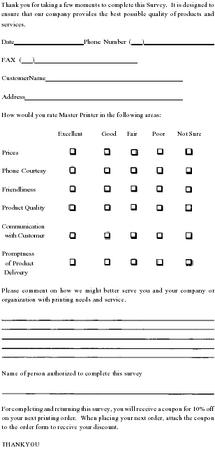
Comment about this article, ask questions, or add new information about this topic: